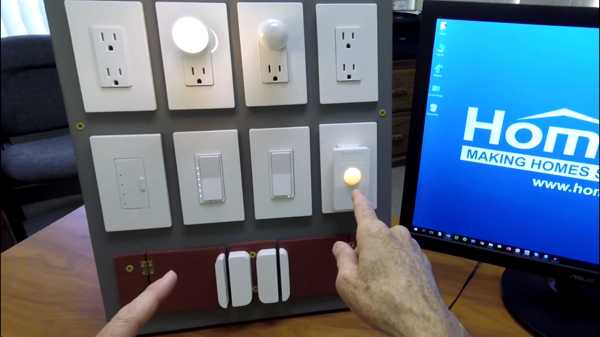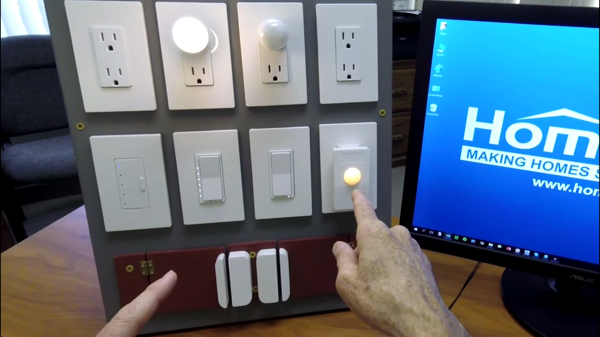Note: As an Amazon Associate I earn from qualifying purchases.
Smart home upgrade: Bought the HomeSeer HSM200 Z-Wave Sensor (2024)
Introduction
I recently purchased the HSM200 Multi-Sensor for my smart home setup to simplify things and keep it clutter-free. This device combines motion sensing, temperature, and light detection in one unit.
Specifications
| Property | Value | Property | Value |
|---|---|---|---|
| Brand | HomeSeer | Color | White |
| Power Source | AC | Item Weight | 2.39 Ounces |
| Maximum Range | 12 Meters |
Photos
Click on photos to enlarge them:
Prices
Check prices of the HomeSeer HSM200 Z-Wave Sensor with RGB Indicator on:
Understanding the HSM200 Features

In my investigation of the HSM200 Multi-Sensor, I discovered it is a valuable accessory for enhancing a HomeSeer HS3 system. This device can detect motion, temperature, and light levels. These features are essential for anyone aiming to optimize their home’s functionality and improve security. However, keep in mind that the HSM200 may not meet every user’s performance expectations regarding these aspects.
Here’s a description of the HSM200’s main attributes:
Motion Sensing: Useful for activating actions such as turning lights on and off automatically based on detected motion.
Temperature Sensor: Useful for regulating heating and cooling systems to ensure comfort.
Adjusts indoor lighting based on natural light changes and uses Light Level Detection to ensure optimal illumination by continuously monitoring and responding to changing light conditions.
LED Annunciator: Displays seven distinct colors to signal various home conditions.
AC Powered: No battery replacements needed, which cuts down on maintenance.
Z-Wave Repeater: Enhances the range and effectiveness of your Z-Wave network by amplifying and retransmitting Z-Wave signals.
One of the interesting features is the RGB LED that can change color in seven ways based on triggers. This function allows the HSM200 to act as a visual signal for occurrences like motion detection or door unlocking, enhancing both functionality and style in a smart home.
The line-powered design is an advantage as it eliminates the worry of batteries running out at inconvenient times. Additionally, it functions as a repeater to enhance your Z-Wave network’s strength and reliability.
On the downside, some users have raised concerns about the sensors’ accuracy and quickness, particularly the light level sensor. This could be problematic for those who require exact readings for light-based triggers. The motion sensor also receives mixed feedback regarding its dependability and precision, suggesting potential areas for improvement or the need for more comprehensive setup and fine-tuning.
As a smart home enthusiast, my focus is often on ensuring that every device I integrate is as effective as it claims to be. While I can appreciate the HSM200’s potential as a multipurpose sensor, I’m cautious about its inconsistent performance reported by some users. However, considering its compatibility with diverse systems like HomeSeer, Hubitat, and SmartThings (with appropriate drivers), it’s clear that the device has a level of versatility that is highly desirable. Despite some drawbacks, I believe the HSM200 has the potential to be a valuable asset, especially for those willing to invest the time in fine-tuning its settings.
Real-life Performance and Issues

When we discuss smart home devices, the HSM200 has caught my attention due to its versatile features in motion sensing, temperature detection, and light measurement. Integrating this sensor into a smart home system provides both advantages and drawbacks, as I discovered during my experimentation:
Pros:
This device is connected to a power source through a plug, eliminating the need for batteries and providing the user with no batteries to worry about. Using this device is hassle-free as you don’t have to concern yourself with battery replacement or charging.
Multisensory inputs are invaluable. Motion detection can be a trigger for security or automation sequences, while temperature readings inform my HVAC system.
This device serves as a night light with seven distinct colors. It automatically transitions between these hues based on specific triggers. This feature offers an attractive ambient lighting effect.
Works seamlessly with a range of smart home hubs—HomeSeer, Hubitat, Home Assistant, and SmartThings (with HomeSeer Edge Driver).
As a Z-Wave repeater, this device enhances the network’s range and resilience.
Cons:
Light level sensing can be slow to respond and unreliable, which is a letdown considering its importance for home automation based on natural light conditions.
Motion sensing can sometimes appear sporadic, and temperature readings have been known to be somewhat inaccurate in certain units.
Controlling the LED functionality can be challenging and may involve delving into detailed settings and potentially making adjustments.
Users of other home automation systems such as Wink or Vera might encounter limitations when attempting to use this system due to compatibility issues.
Users have complained about a persistent loud humming sound. This issue might be problematic in quiet home settings.
The HSM200 is a plug-and-play device that fits into a standard outlet and works well with various smart hub configurations. One of its notable advantages is its function as an indicator light for SmartThings connected locks. With this feature, I can quickly determine if doors are locked by observing visual cues, ensuring peace of mind before going to bed.
The motion detection is another area that needs attention. While it works excellently in some cases, especially with Hubitat, where it joins the mesh well, some units have reported spotty motion detection. It’s something potential users should be aware of—your mileage may vary.
The customer service at HomeSeer responded quickly when I encountered problems. They were prepared to send a replacement for a faulty unit, demonstrating strong support. However, there are concerns about the consistency of basic functions.
The HSM200 holds significant potential value in a smart home setup, making it an alluring choice for establishing a cohesive and unified environment or for those currently embracing the HomeSeer ecosystem. However, realizing its full potential may necessitate some patience and experimentation.
Integration with Smart Home Hubs

Integrating the HomeSeer HSM200 into my smart home system involved both successes and challenges. I looked forward to using it as a motion, temperature, and light sensor, along with its role as a Z-Wave repeater. The experience, however, was a blend of satisfaction and some frustration.
My starting point was integrating with various hubs. I discovered the following:
The HSM200 integrates seamlessly with HomeSeer and Hubitat, granting you complete control.
SmartThings: Needed HomeSeer Edge Driver for advanced functions, but functioned well after setup.
Home Assistant can be identified easily. However, using its LED indicator took more effort.
Device recognition issue: The device was identified but didn’t work correctly, resulting in a return.
The multi-hued LED indicator was useful for distinguishing home events, but its high-pitched hum was bothersome in quiet environments.
With Hubitat, using the “EzMultiPli” driver provided easy access to all sensors and allowed for customizing LED colors. Installation was straightforward, and its plug-and-play design meant no batteries were required.
My SmartThings setup utilized the device for managing lighting and door lock status. Constantly operating motion detectors guaranteed precise readings with minimal false alarms.
Some users have reported sporadic motion reporting and problematic light sensor readings, as well as inaccurate temperature readings, which have resulted in readings as low as -97F. These issues with the temperature and light sensors have caused delays and questionable readings, making it difficult for users to trust the device’s accuracy. The inaccurate temperature and light data were particularly disappointing, especially since the product comes at a premium price.
Here are the main points about the integration:
The Compatibility is generally good, but varies among different platforms with mostly favorable results using specific hubs.
Performance: Some hubs maximize its capabilities; otherwise, it’s inconsistent.
User Experience can be straightforward for some individuals, while complex and frustrating for others.
Reliability: Generally robust with some noted sensor inaccuracies.
Value: The cost may be a sticking point, especially if not all features are utilized.
In the realism of smart home technology, I value the device’s compact design and small size as they play a crucial role in expanding my Z-Wave network’s reach in limited spaces. This becomes particularly important when dealing with space constraints, enabling me to incorporate more devices into my network. However, its compatibility with specific hubs and the reliability of its sensors pose challenges that may not be hassle-free additions I anticipated. Nevertheless, for those open to customization, this device offers significant smart home integration possibilities, allowing for a more comprehensive and efficient automation system.
Final Verdict on HSM200

Stepping into the world of smart home technology, I focused on minimalism and efficiency. I examined the HSM200 due to its multifunctional features, capable of detecting motion, measuring temperature, and adjusting to light levels. Key insights from my usage:
Pros:
This device incorporates multiple sensors in a small package.
This device is powered by AC, avoiding the need for battery replacements.
Acts as a repeater, enhancing Z-Wave network range
LED colors can be customized for different notifications.
This device works with various smart home systems using Edge Driver.
Cons:
Inconsistent motion detection
The light sensor may not react promptly or provide precise readings.
Setting up might be difficult for those less familiar with technology.
In practical terms, the HSM200 delivers a mixed bag. On the one hand, the line power feature is a huge plus; it’s plugged in and forget, with no worries about changing batteries. The unit’s ability to act as a Z-Wave repeater is also an unsung hero, extending the reach of my network. When it comes to integration, being able to connect it to HomeSeer, Hubitat, and SmartThings (with some tinkering) has been beneficial. I’ve used it to automate indoor lighting to respond to levels of natural light, which has been incredibly convenient for maintaining a minimalistic and clean aesthetic without the usual clutter of sensors everywhere.
However, the HSM200 has some drawbacks. The motion detection isn’t consistent and can be unreliable for security purposes. Temperature readings in my home have been incorrect, showing unusually low degrees. Furthermore, the light sensor sometimes lags or reports inaccurate levels.
Nevertheless, I’ve managed to resolve some issues with the device through online communities and custom drivers. I value the strong community support for smart home enthusiasts that enables these user-developed solutions.
To sum up, the HSM200 has advantages and disadvantages, but its positives outweigh the negatives, especially for users comfortable with problem-solving. For individuals seeking a versatile sensor for a minimalist home environment, this is a solid option, provided they’re prepared to address occasional challenges. The HSM200 may not be perfect, but it offers significant control and customization for HomeSeer ecosystem users, making the initial setup hassle worthwhile.


